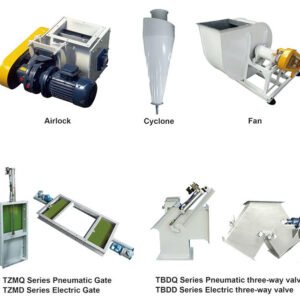Description
Technical Specifications & Engineering Design
Rotor Configuration Options
-
Open-Ended Rotors: Standard design for free-flowing materials
-
Closed-End Rotors: Minimizes air leakage for pressure differentials >0.5 bar
-
Pocketed Rotors: Enhanced capacity for low-density materials
-
Shrouded Rotors: Reduces particle degradation in fragile materials
Performance Specifications
-
Size Range: 100-600 mm diameter, 150-1200 mm length
-
Capacity: 0.5-450 m³/hour depending on material characteristics
-
Pressure Differential: Standard to 1.0 bar, high-pressure to 2.5 bar
-
Operating Speed: 15-45 RPM with variable frequency drive options
Construction Materials
-
Housing: Cast iron, carbon steel, 304/316 stainless steel
-
Rotor: Precision-machined steel with various surface treatments
-
End Plates: Machined with multiple sealing options
-
Shaft & Bearings: Heavy-duty designs with various sealing arrangements
Specialized Applications & Performance Data
| Industry Application | Rotor Type | Clearance Specification | Special Features | Performance Metrics |
|---|---|---|---|---|
| Food & Pharmaceutical | Polished stainless | 0.10-0.25 mm | CIP capability, USDA acceptance | >99.5% containment |
| Explosive Dust Environments | Conductive materials | 0.15-0.30 mm | Explosion-proof, grounding brushes | <10 mJ ignition energy |
| Abrasive Materials | Hard-faced surfaces | 0.40-0.80 mm | Replaceable liners, hardened components | 2,000-5,000 hour life |
| High Temperature | Thermal expansion design | 0.20-0.50 mm | Cooling fins, high-temp bearings | 400°C continuous operation |
Operational Parameters:
-
Air Leakage: 1-8% of rated capacity depending on design
-
Volumetric Efficiency: 65-85% based on material characteristics
-
Power Consumption: 0.75-30 kW depending on size and application
-
Noise Levels: 70-82 dB at operating conditions
Engineering Innovations & Technical Features
Advanced Sealing Technology
-
Rotor Tip Seals: Spring-loaded PTFE or composite materials
-
Shaft Seals: Lip seals, mechanical seals, or packing gland arrangements
-
End Clearance Adjustment: Thermal expansion compensation systems
-
Purge Connections: Air injection for seal protection and cleaning
Drive System Options
-
Direct Drive: Compact design with integrated gear motor
-
Chain Drive: Heavy-duty applications with torque limitations
-
Belt Drive: Vibration damping for sensitive applications
-
Explosion-Proof Motors: Certified for hazardous locations
Monitoring & Control
-
Speed Sensors: RPM monitoring for feed rate control
-
Bearing Temperature: Thermal protection for continuous operation
-
Torque Monitoring: Overload protection and maintenance indication
-
Level Detection: Interface with upstream equipment
Industry-Specific Implementation
Food & Grain Processing
In flour mill and grain handling applications, sanitary airlocks prevent system contamination while maintaining pneumatic conveying efficiency. One major milling operation documented 99.7% pressure retention while handling 25 tons/hour of wheat flour, with maintenance intervals extending to 4,000 hours through proper clearance management and preventive maintenance.
Plastic & Chemical Processing
For pellet and powder handling, specialized airlocks prevent particle degradation and material leakage. A polypropylene production facility achieved 98.5% volumetric efficiency while maintaining product integrity, with rotor speeds optimized to minimize pellet damage at 22 RPM.
Biomass & Renewable Energy
In wood pellet and biomass handling, abrasive-resistant airlocks extend service life in challenging environments. One biomass power plant increased component life from 800 to 2,500 hours through implementation of tungsten carbide-coated rotors and replaceable wear liners.
Minerals & Cement
Heavy-duty airlocks handle highly abrasive materials with minimal maintenance. A cement plant processing fly ash documented 99% availability over 12 months operation, with planned maintenance reducing emergency downtime by 85%.
Operational Economics & Maintenance
Total Cost of Ownership Analysis
-
Equipment Investment: $2,000-$25,000 based on size and specifications
-
Installation Costs: 15-30% of equipment cost for proper integration
-
Operating Costs: $0.50-$2.00 per operating hour including power and maintenance
-
Replacement Parts: Rotors, seals, and bearings as primary wear components
Maintenance Optimization
-
Daily: Visual inspection, unusual noise monitoring
-
Weekly: Bearing temperature checks, seal condition assessment
-
Monthly: Clearance verification, drive system inspection
-
Annually: Complete overhaul and performance validation
Performance Validation Methods
-
Air Leakage Testing: Pressure decay or flow measurement
-
Capacity Verification: Volumetric efficiency calculation
-
Wear Assessment: Clearance measurement and component inspection
-
Efficiency Monitoring: Power consumption versus throughput
Expert Q&A for System Designers
Q1: How do we determine the appropriate rotor clearance for specific applications?
A: Clearance selection depends on material characteristics (abrasiveness, particle size), temperature variations, and pressure differential. General guidelines: 0.1-0.3mm for fine powders, 0.3-0.6mm for granular materials, and 0.5-0.8mm for abrasive applications. Always consider thermal expansion in high-temperature applications.
Q2: What are the key factors in selecting between different rotor designs?
A: Consider material characteristics (free-flowing vs. cohesive), required efficiency, particle sensitivity, and maintenance requirements. Open-ended rotors suit most applications, while closed-end designs maximize efficiency in pressure systems. Shrouded rotors protect fragile materials, and pocketed designs enhance low-density material handling.
Q3: How can we minimize air leakage in high-pressure differential applications?
A: Implement closed-end rotors with tip seals, use adjustable end clearances, consider multiple purge systems, and optimize rotor speed. For extreme conditions, specialized designs with labyrinth seals or dual-airlock arrangements may be necessary.
Q4: What maintenance practices maximize airlock service life?
A: Regular clearance checks and adjustment, proper lubrication schedules, contamination prevention, and monitoring of operational parameters. Implementing predictive maintenance through vibration analysis and thermal monitoring can identify issues before failure occurs.
Q5: How do we properly size an airlock for a specific application?
A: Calculate required capacity considering material density and flow rate, verify pressure differential capabilities, assess material characteristics for appropriate design selection, and consider future operational requirements. Most manufacturers provide sizing software and technical support for proper selection.




Reviews
There are no reviews yet.